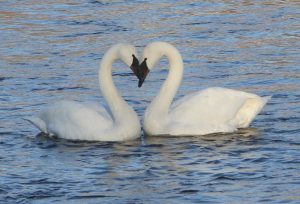
By Kristy Walker, Minnesota
Being a wildlife-and-nature photographer requires patience, perseverance, curiosity, wonder, discipline, and most of all, love. What else but love could motivate me to be outdoors in sub-freezing temperatures for the chance to catch a breathtaking photo?
And how do I know all the hours of waiting will yield that special image? I don’t.
Is it chance or happenstance? Or something else?
I have a secret for photographing wild and unpredictable creatures in all kinds of weather and terrain. I rely on my inner spiritual guide, the Mahanta, to guide me to the right times and places for capturing love in motion. If my photos in some way help instill wonder or renew people’s love and respect for all life, then following my inner guidance, even when my mind or logic tells me differently, is well worth the effort.
Trumpeter Swans
For many years, in January through early March, I have been going to Monticello, Minnesota, to photograph and spend time in the presence of trumpeter swans. Annually nearly two thousand trumpeter swans make their winter home along the Mississippi River there. I document and enjoy the beauty of this natural preserve for a North American bird with wings that can span more than ten feet.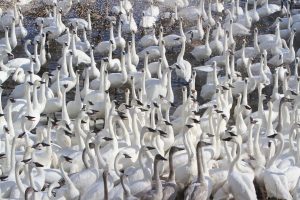
One winter day it was twenty degrees below zero Fahrenheit. Not surprisingly, I was the only human with the swans gathered by the river. Even they were trying to escape the cold, huddling together with heads neatly tucked into their bodies for warmth. I am sure they were wondering why I was still out there, since a frigid, blowing wind made it feel even colder.
While I waited for the right moment to photograph, one of the swans near me stood up and spread her wings like a cape. It was as if she were saying, “OK, now take the shot and go home. It’s too cold for you here.” I was stunned and humbled by her beauty.
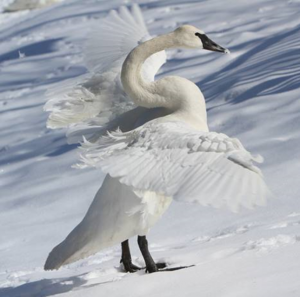 The Sound of God
The Sound of God
Often when I go to Monticello, I like to photograph the swans as they head toward or away from the river. This way I can capture their beautiful white wings against a backdrop of blue sky. The teachings of Eckankar emphasize that the building blocks of creation are the Light and Sound of God, also known as the ECK.
While watching the trumpeter swans, I listen to the hushed sound of their wings as they fly overhead, and I am more open to the Light and Sound of God around me and the soft presence of Divine Spirit.
When I go home after a day with the swans, I still hear their wings and voices. These sweet sounds become a spiritual exercise that connects me to that loving presence.
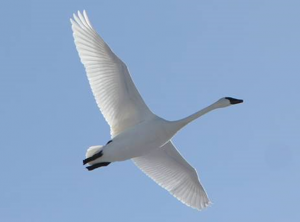
Rescuing a Swan
The Mahanta also guides me to help swans in ways I could never have imagined. Some of my friends rescue injured swans, eagles, and other birds. They once contacted me about photographing a swan they were going to rescue in Wisconsin. They feared the bird had lead poisoning. Even after their flock left the area, the sick swan’s family had stayed behind to care for the weakened bird.
My friends got into kayaks and rowed to the swan that could no longer fly. As they approached the bird, her family flew away.
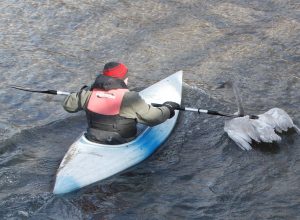 A local television news channel used my photos in a story about the rescue. The photos helped to convey an important message—that abandoned lead fishing tackle is a major cause of lead poisoning in wildlife.
A local television news channel used my photos in a story about the rescue. The photos helped to convey an important message—that abandoned lead fishing tackle is a major cause of lead poisoning in wildlife.
This rescue allowed me to see love in action. The swan’s family, the rescue team, the news crew, and myself—all were connected to the swan by that precious thread of love.
—Photos by Kristy Walker

Merci pour le partage de cet amour.
What a lovely story that shows god’s love working on many subtle levels , thank you Kristy!
Thank you for sharing such a remarkable story. I am deeply touched.
Thank you Kristy for sharing such a delightful experience. It truly “warmed my heart “. A touching expression of Divine Love.
The story was very beautiful because of the experience of light and sound, in the world of beautiful spirits in the ponds are slowly living and are much more beautiful than this world in peace, thanks for the pictures and gratitude for this reminder.
Especially touched by the swan rescue, on this Friday Fast day. Thank you for sharing these beautiful images and stories, so spiritually restorative in a complex and busy world.
Kristy’s devotion–to her art, to her plant and animal friends, to the Mahanta–is an inspiration to us all.
The ability to photographically capture spiritual communication between animals, and between animals and humans, isn’t an easy thing to do. Kristy’s photography does this. The images alone opened my heart – and so did the story. I then went on to read her Hawk story on this blog, and was amazed. Thank you for this wonderful blog.